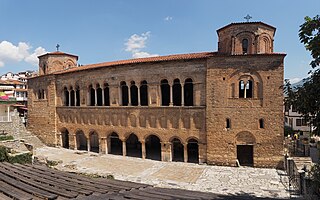
Hagia Sophia, officially the Hagia Sophia Grand Mosque, is a mosque and former church serving as a major cultural and historical site in Istanbul, Turkey. The last of three church buildings to be successively erected on the site by the Eastern Roman Empire, it was completed in AD 537. The site was an Eastern rite church from AD 360 to 1453, except for a brief time as a Latin Catholic church between the Fourth Crusade and 1261. After the fall of Constantinople in 1453, it served as a mosque until 1935, when it became a museum. In 2020, the site once again became a mosque.

Byzantine architecture is the architecture of the Byzantine Empire, or Eastern Roman Empire, usually dated from 330 AD, when Constantine the Great established a new Roman capital in Byzantium, which became Constantinople, until the fall of the Byzantine Empire in 1453. There was initially no hard line between the Byzantine and Roman Empires, and early Byzantine architecture is stylistically and structurally indistinguishable from late Roman architecture. The style continued to be based on arches, vaults and domes, often on a large scale. Wall mosaics with gold backgrounds became standard for the grandest buildings, with frescos a cheaper alternative.

Polotsk or Polatsk is a town in Vitebsk Region, Belarus. It is situated on the Dvina River and serves as the administrative center of Polotsk District. Polotsk is served by Polotsk Airport and Borovitsy air base. As of 2024, it has a population of 79,579.

A templon is a feature of Byzantine churches consisting of a barrier separating the nave from the sanctuary near the altar.

Saint Sophia Cathedral in Kyiv, Ukraine, is an architectural monument of Kievan Rus'. The former cathedral is one of the city's best known landmarks and the first heritage site in Ukraine to be inscribed on the World Heritage List along with the Kyiv Cave Monastery complex. Aside from its main building, the cathedral includes an ensemble of supporting structures such as a bell tower and the House of Metropolitan. In 2011 the historic site was reassigned from the jurisdiction of the Ministry of Regional Development of Ukraine to the Ministry of Culture of Ukraine. One of the reasons for the move was that both Saint Sophia Cathedral and Kyiv Pechersk Lavra are recognized by the UNESCO World Heritage Program as one complex, while in Ukraine the two were governed by different government entities. The cathedral is a museum.

The Church of Saint Sophia is a church in Ohrid, North Macedonia. The church is one of the most important monuments of North Macedonia, housing architecture and art from the Middle Ages.

Neo-Byzantine architecture was a revival movement, most frequently seen in religious, institutional and public buildings. It incorporates elements of the Byzantine style associated with Eastern and Orthodox Christian architecture dating from the 5th through 11th centuries, notably that of Constantinople and the Exarchate of Ravenna.
Saint Sophia may refer to

Hagia Sophia is a formerly Greek Orthodox church that was converted into a mosque following the conquest of Trabzon by Mehmed II in 1461. It is located in Trabzon, northeastern Turkey. It was converted into a museum in 1964 and back into a mosque in 2013. The building dates back to the thirteenth century, when Trabzon was the capital of the Empire of Trebizond. It is located near the seashore and two miles west of the medieval town's limits. It is one of a few dozen Byzantine sites extant in the area and has been described as being "regarded as one of the finest examples of Byzantine architecture".

The Cathedral of Saint Sophia, the Holy Wisdom of God in Veliky Novgorod, Russia, is the cathedral church of the Metropolitan of Novgorod and the mother church of the Novgorodian Eparchy.
Saint Sophia Cathedral may refer to:

The architecture of Kievan Rus' comes from the medieval state of Kievan Rus' which incorporated parts of what is now modern Ukraine, Russia, and Belarus, and was centered on Kiev and Novgorod. Its architecture is the earliest period of Russian and Ukrainian architecture, using the foundations of Byzantine culture but with great use of innovations and architectural features. Most remains are Russian Orthodox churches or parts of the gates and fortifications of cities.

The conversion of non-Islamic places of worship into mosques occurred during the life of Muhammad and continued during subsequent Islamic conquests and invasions and under historical Muslim rule. Hindu temples, Jain Temples, churches, synagogues, and Zoroastrian fire temples have been converted into mosques.

Holy Wisdom is a concept in Christian theology.

Hagia Sophia Church, also known as the Church of Saint Sofia and the Old Bishopric is an Eastern Orthodox church in Nesebar, eastern Bulgaria. It is situated in the old quarter of the town which is part of the UNESCO World Heritage Site list and of the 100 Tourist Sites of Bulgaria.

Selimiye Mosque, historically known as Cathedral of Saint Sophia or Ayasofya Mosque, is a former Christian cathedral converted into a mosque, located in North Nicosia. It has historically been the main mosque on the island of Cyprus. The Selimiye Mosque is housed in the largest and oldest surviving Gothic church in Cyprus possibly constructed on the site of an earlier Byzantine church.

The Cathedral of Holy Wisdom was a cathedral in Polotsk that was built by Prince Vseslav Briacheslavich (1044–1101) between 1044 and 1066. It stands at the confluence of the Polota River and the Western Dvina River on the eastern side of the city and is probably the oldest church in Belarus.
Ayasofya Mosque may refer to:

The Cathedral of the Holy Wisdom of God or Saint Sophia Cathedral in Harbin is a former Russian Orthodox church located in the central district of Daoli, Harbin City, Heilongjiang, China.
Saint Sophia Church may refer to:
This page is based on this
Wikipedia article Text is available under the
CC BY-SA 4.0 license; additional terms may apply.
Images, videos and audio are available under their respective licenses.














